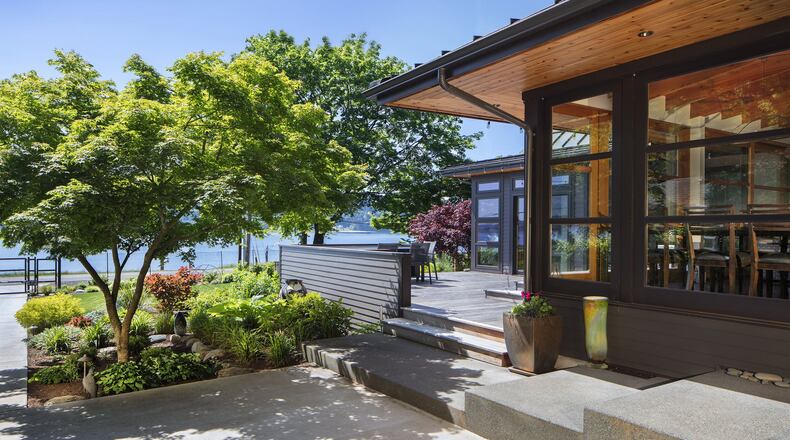BAINBRIDGE ISLAND, Wash. — When this house belonged to other people, it was a mystery. Then came a miracle.
Now it belongs to Bob and Mary Carlson. And it is magical.
Up until a few years ago, the Carlsons lived in an award-winning custom home on Bainbridge Island designed by architect Tom Kuniholm (it was The Seattle Times/AIA Home of the Year in 1999) — “Fabulous,” Mary says, “but a little too much. It was time to downsize.”
Here’s the mystery: “We lived on top of the mountain and always walked by this house and loved it,” she says. “It was small but eclectic, with a red metal roof. You could never see the details; it was set back farthest from the road.”
Here’s the miracle*: “I was walking after a hip replacement and saw a couple of real estate signs: For Sale By Owner,” says Mary. “I called and said, ‘We live close by. Can you be there in 20 minutes?’ We looked around. We looked at each other. The way the light on the floating wall looked like Japanese temples, and [our daughter] Nora had gone to school in Japan — it was just fabulous. We said, ‘Can we bring our architect?’ We called Tom and were here the next day. As it ended up, we made an offer. They sat us down and said, ‘We have all these offers.’ But they also said they felt we were the right people for this house.” (*Adds Bob, as a welcome antidote to any perceived journalistic hyperbole: “It’s a miracle we got this place.”)
And here’s the magic: Everywhere. Everywhere, there’s magic. You just cannot conjure how this house ever belonged to anyone else.
Originally, in the 1930s, this blissful, tucked-back site facing sparkling Rich Passage was home to a 36-by-36-foot beach cabin, says Kuniholm. Then, in 1984, “A very young Tom Kundig remodeled it with a Pacific Northwest/Japanese-inspired theme.”
Thirty or so years later, a few tricky spots had appeared: An attached addition, originally intended as a B&B, was rotted and unsalvageable. The main bathroom “was a big square with two cubbies,” says Mary. Some ceilings were 7 feet high.
“Most people would pull the whole thing down, but they appreciated the bones of it,” Kuniholm says. “We knew the game plan was a downsize, not an upsize, and we knew it’d be challenging to rip apart — where do you stop? There was enough here to make a magnificent little cottage and expand.”
Like a cottony bunny plucked from a top hat, a major remodel materialized — a light-filled new master-bedroom pavilion, oriented to water views around a new courtyard; a supercustom new kitchen, expanded with a popout; a graceful new Japanese-style entry; an elegant new master bathroom, also Japanese-style; and new stairs and skylights — all while respecting those who’d worked this space before.
“We did a lot to the house, but it’s still Tom Kundig’s work from when he was in his 20s,” Kuniholm says. “Some roofs, exposed framing and windows remain from that time. The new project expands on many of those aesthetic cues, updated.” From the original cabin, an old brick chimney, a slightly off-center but still-striking white fireplace and some walls remain — “but not much else.”
Not as much remains of the Carlsons’ previous possessions, either, which is exactly the point of downsizing. Bob is a glass artist and author, and Mary creates one-of-a-kind books, along with ceramics, photography and poetry. Between works of art and leisurely travel, they had amassed an extensive collection of meaningful pieces.
“So much of who we are is our stuff,” says Mary, who did all the interior design. “When we moved, we had so much stuff. We went through it with Nora. We got to choose what we couldn’t live without, and marked that with red tags — then green if ‘up for grabs,’ and orange if ‘not sure.’ We took all the stuff that was coming here and shut it off, and displayed everything else. We had a big [party]: Everyone got a glass of wine and picked a number out of a hat. We had about 150 things. Whoever had No. 1, we asked: ‘What do you want?’ Then 2 and 3. Someone got a polka-dot couch, or a chandelier from the ’20s. Now we go to our friends’ houses, and there’s that fabulous polka-dot couch.”
The stuff that made the cut is the most special of the special: Bob’s giant fired-on-glass/gold-leaf piece “Buddha,” on a towering stairway wall; the life-size multimedia piece “The Traveler,” by Amos Zook, at the foot of the new stairway; the mirror in the entry that had belonged to Bob’s mom.
Mary calls the resulting aesthetic — a comfortable, comforting blend of antique and contemporary — “eclectic” (it’s the same word she uses to describe this stretch of Bainbridge beach and, you might recall, the preremodeled house itself). On the surface, “eclectic” might imply “easy.” It is not.
“Mary had a tape measure and measured the wall to make sure our Gayle Bard painting would fit,” Bob says, and the lighting was crucial. “The place had to work for art. When you look at the space and the art, it’s just right. Ambience is ultimately important. I can feel the skylights. I know how the space reacts.”
It is magical. Maybe even miraculous. But there’s no mystery anymore — just a little mystique: like how everyone knew the Carlsons were the right people for this house.
About the Author
Keep Reading
The Latest
Featured


